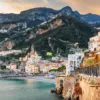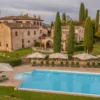The borders of the Chianti region are difficult to define, since geographically we can only talk about the hilly area between Florence and Siena, historically it consisted of the settlements of Gaiole, Radda and Castellina
...., which were part of the Florentine military legion of Chianti, and in recent times the borders of Chianti have been determined mainly by wine, since in 1932 Chianti was divided into 8 subregions: Classico, Colli Aretini, Colli Fiorentini, Colline Pisane, Colli Senesi, Montalbano, Montespertoli and Rufina. Most of the places that were included in the region added 'in Chianti' to their name, such as Greve in Chianti, which added its name in 1972.
Cheers!
Tuscany is one of the most famous regions in the world not only for its wine, although Chianti is one of the most famous wines, but also for its beautiful art, excellent olive oil and, of course, the movies that were shot in the cities and in the countryside. But the glory of Tuscany was not always synonymous with good wines, as this wine-growing region was long known for only mediocre wines. In order to better understand Tuscan wines, we must first know the most typical wine of the Chianti region. Thinking of Chianti wine we think of a bottle in a straw basket, called 'fiasco', but this bottle shape is only used by a few winemakers today, the vast majority of them opting for the classic bottle shape. Although the oldest records of Chianti wine date back to the 13th century, it can be traced back to the 14th century that Chianti was a white wine. Changes followed until the 18th century, when it was already known as red wine, but the final formula was written down in the middle of the 19th century by the Italian statesman Bettino Ricasoli. According to his 'recipe', 70 percent of true Chianti is red sangiovese, 15 percent canaiolo, 10 percent white malvasia, and the other 5 percent other local reds. In the 1970s, winemakers began to reduce the amount of white wine and the criteria became looser, and only winemakers from the Chianti Classico sub-region, which was already declared a wine-growing region by the Medici Cosimo III, can boast of the famous black rooster (gallo nero) sign. at the beginning of the 18th century. The last change occurred in 1996, when winemakers were given more freedom in the choice of grapes and many of them completely eliminated the white varieties. Since these wines were in many cases even better than ordinary Chiantis, they were named 'Super Tuscans', first informally, and later as a means of an effective marketing campaign. Only in the last decade or two has the world's wine world started to take Tuscan wines seriously, and in the last few years winemakers have reached the highest standards thanks mainly to some Tuscan pioneers, such as Piero Antinori, who was the first to completely ignore the dictates of the wine industry union and in 1971 created the wine known today as Tignanello, based on Sangiovese and Cabernet Sauvignon.
A delicious discovery
Probably, while getting to know the Chianti region, we will be most surprised by the large number of foreigners who have found their little paradise on earth in the Tuscan hills. Many call it a small town Greve and Chianti gateway to the Chianti region. Since the Middle Ages, the town has been known for the triangular shape of the main square and its wine museum and Le Cantine wine shop, in which we can try hundreds of different wines. Castles of important aristocratic families stand on the hills near the city. One of the castles Castello di Vicchiomaggio, rises above as many as 130 hectares of vineyards, and in the castle, with advance notice, we can also organize a wine tasting. In the castle Castello di Verrazzano Giovanni da Verrazzo, the explorer who discovered New York Bay, was born. Just a few kilometers south of Grevo, you can visit the largest settlement in Chianti Panzano. Meandering through the old part of town is a lot of fun because of the many wine shops where you can try chianti. A visit to a famous butcher shop is especially fun Antica Macelleria Cecchini, which is known mainly for its Florentine steaks. While we wait for our delicious piece of meat, the owner usually quotes passages from Dante's Divine Comedy. Only two kilometers from Panzano is the estate Panzanella, which has been known for its excellent Chianti since 1427. Lovers of history, especially of the Etruscan period, will love to stop by Castellina and Chianti because Archaeological Museum of Chianti Senese or because of the excellent salami, which, along with wine and olive oil, are among the most delicious products of Tuscany. It is one of the places that has best preserved its medieval image Radda and Chianti, where we can still admire many coats of arms of noble families on the facade of the palace Palazzo del Podesta, which was the seat of the League of Chianti for more than four centuries.
In a castle, a villa or on a farm
Tuscany offers excellent possibilities for vacations. Between tours and wine tastings, you can relax in private villas, luxuriously converted castles or simple guesthouses. Castello di Vertine is actually a whole village surrounded by walls, where you can indulge in yoga and Ayurvedic massages or enjoy yourself by the pool. It also offers six luxury apartments Castello do Meleto, while it is Villa Bordoni a luxurious country hotel with 10 rooms, where we can also take part in cooking classes. Those who would prefer to stay in a renovated 16th century farmhouse will surely be impressed by La Locanda, which has only six rooms and one suite, but of course there is also a swimming pool where you can cool off on hot summer nights.
Wine pleasures
While getting to know the wine-growing regions of Tuscany, the opportunity to taste Chianti should not be missed. The following producers stand out for their wine quality: Castello di Ama with an extraordinary 1997 Chianti, and their Merlot is also excellent; Fattoria de Felsina in addition to Chianti, it is also famous for the super Tuscan Fontalloro; Castelli di Fonterutoli owned by the Mazzei family; Tenuta Fontodi in addition to classic Chianti, it also offers excellent Shiraz; and Querciabella, which is also one of the leading providers of white wines in Tuscany.
Information:
– Wine museum and wine shop Le Cantine: www.lecantine.it
– Castle Castello di Vicchiomaggio: www.vicchiomaggio.com
– Castle of Castello di Verrazzano: www.verrazzano.com
– Butcher Antica Macelleria Cecchini: www.dariocecchini.com
– Panzanello Estate: www.panzanello.it
– Chianti Senese Museum: www.museoarcheologicodelchianti.it
– Palazzo del Podestà: www.radda-in-chianti.com
– Castle of Castello di Vertine: www.castellovertine.it
– Castle Castello di Meleto: www.castellomeleto.it
– Hotel Villa Bordoni: www.villabordoni.com
– Hotel La Locanda: www.lalocanda.it






